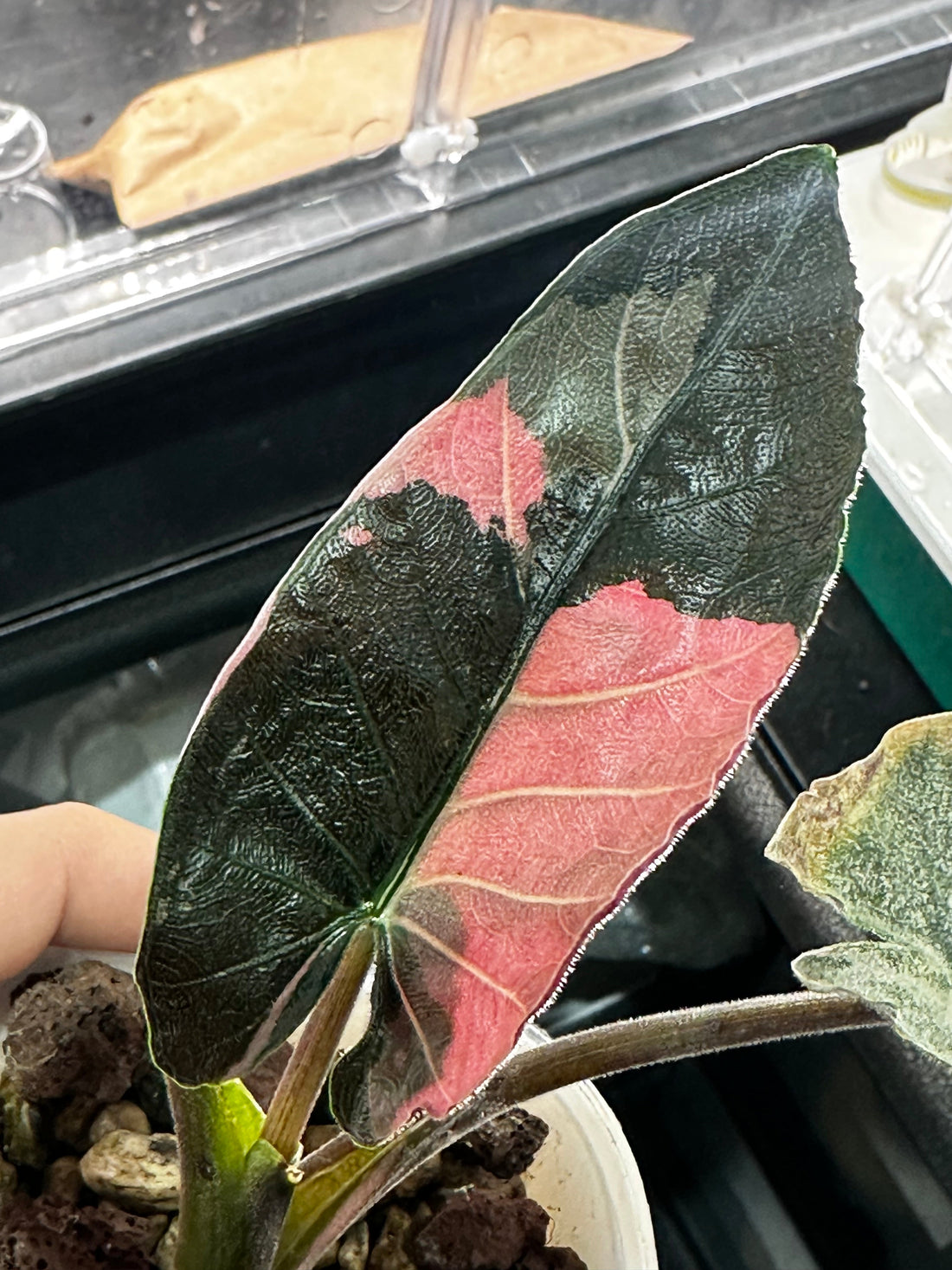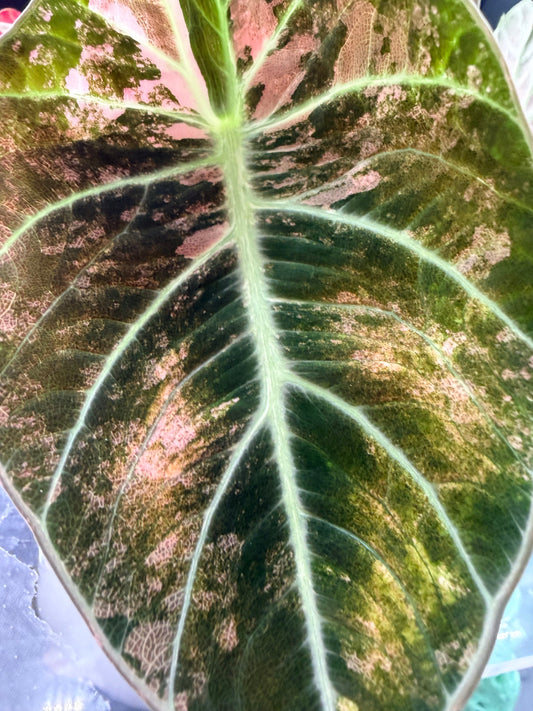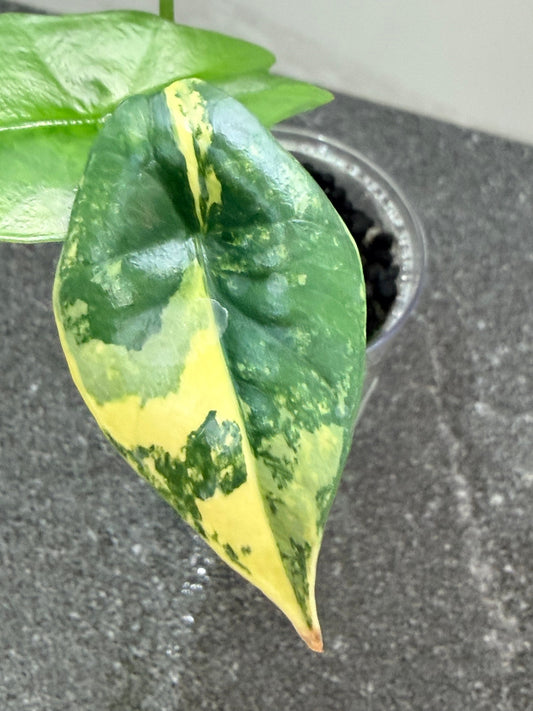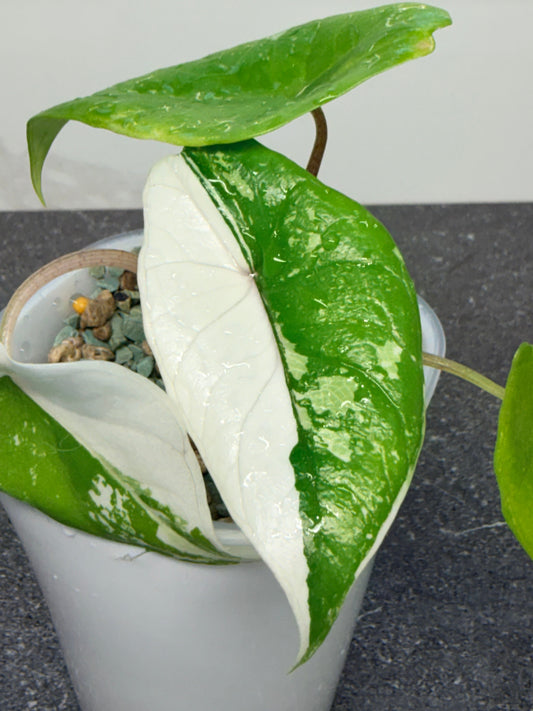
The Mystery of Pink Variegation in Alocasia
Share
The Mystery of Pink Variegation in Alocasia: Science Meets Beauty
Pink variegation in Alocasia plants is perhaps the most captivating and misunderstood type of leaf coloration in the plant world. Unlike the stark whites of albo variegation, pink-variegated Alocasia display soft pastel hues or bright neon pink that seem almost unreal. In this comprehensive guide, we'll uncover the fascinating science behind pink variegation and explain why these plants are among the most coveted in any collection.
What Is Pink Variegation?
Pink variegation refers to the appearance of pink, rose, or pale lavender tones on Alocasia leaves. Popular varieties include Alocasia Bambino Pink Variegated, Alocasia Watsoniana Pink Variegated, Alocasia Amazonica Pink , and the stunning Alocasia Yucatan Pink Variegated.
But here's where things get interesting: true pink variegation in Alocasia isn't actually pink pigment at all. It's an optical illusion created by the interaction of missing chlorophyll and the natural pigments already present in the leaf structure.
The Science Behind Pink Variegation
The Chlorophyll Connection
Here's the fascinating truth: the "pink" you see in variegated Alocasias is actually caused by a lack of green chlorophyll mixing with the purple or red pigments (anthocyanins) that exist on the underside of Alocasia leaves. When the top surface of the leaf lacks chlorophyll, these underlying colors become visible, creating that beautiful pink appearance.
In Scientific Terms
Pink variegation occurs through the same chimeric mutation that causes albo variegation—a genetic variation affecting chlorophyll production in certain cells. However, the pink appearance is specifically the result of:
- Anthocyanin pigments naturally present in the leaf tissue, particularly concentrated in the abaxial (underside) epidermis
- Absence or severe reduction of chlorophyll in the variegated sectors
- The remaining cellular structure allowing the red-purple anthocyanins to show through
- Light interaction with the different pigment layers, creating a translucent pink effect
The intensity of pink coloration varies based on the concentration of anthocyanins in the particular Alocasia variety and the degree of chlorophyll deficiency in the affected cells.
In Simple Terms
Think of an Alocasia leaf as a sandwich. The bottom layer has natural purple-red tones (that's why many Alocasia leaves have burgundy undersides), and the top layer normally has lots of green chlorophyll covering it up. When the genetic mutation removes the green from certain areas on top, the purple-red from underneath shines through—like looking through a window at the color below. Our eyes see this combination as pink!
It's similar to putting a white filter over a red light—you get pink. In this case, the "white" is the lack of green chlorophyll, and the "red" is the plant's natural anthocyanin pigments.
Why Not All Variegated Alocasias Are Pink
You might wonder why some variegated Alocasias show white patterns (albo) while others display pink. The answer lies in the underlying pigments present in each variety.
Anthocyanin-Rich Varieties
Alocasia species that naturally produce high levels of anthocyanins in their leaf structure are the ones capable of producing pink variegation. These varieties typically have:
- Darker green upper leaf surfaces
- Purple, burgundy, or red undersides
- Natural metallic or copper tones in their coloring
Examples include Alocasia cuprea (with its naturally coppery leaves), Alocasia azlanii (with deep purple veining), and varieties like Alocasia reginula 'Black Velvet' which have darker, more pigmented foliage.
Low-Anthocyanin Varieties
Alocasia with lighter green leaves and minimal purple undertones will typically display white (albo) or yellow (aurea) variegation instead of pink, because they simply don't have enough anthocyanin pigment to create that rosy effect.
Pink Variegation vs. Pink Princess Phenomenon
It's important to distinguish natural pink variegation from artificially induced pink coloring. Some plants, like the controversial Philodendron 'Pink Congo', have been treated with chemicals that temporarily prevent chlorophyll production, creating artificial pink leaves that eventually revert to green once the chemical wears off after 6-12 months.
Genuine pink-variegated Alocasias are not chemically treated. Their pink coloration is a stable genetic trait (as stable as any chimeric variegation can be) resulting from the natural interaction of chlorophyll deficiency and anthocyanin expression.
How Pink Variegation Develops and Changes
Maturation Effects
One fascinating aspect of pink variegation is how it evolves as leaves mature. In many pink-variegated Alocasias:
- Newly unfurling leaves often show the most intense pink coloration
- As leaves harden and mature, the pink may deepen or shift slightly in tone
- Older leaves may show more stable, consistent pink patterns
- The contrast between pink and green sections often becomes more pronounced with age
This is particularly noticeable in varieties like Alocasia cuprea 'Red Secret' Pink Variegata, where the variegation becomes more vivid and spread across larger portions of the leaf as the plant matures.
Light and Pink Intensity
While light doesn't create variegation, it significantly affects how pink variegation appears:
- Higher light levels (without direct sun) tend to enhance the intensity of pink coloration
- Bright indirect light encourages more anthocyanin production, deepening the pink hues
- Low light conditions can cause pink areas to appear paler or more washed out
- The plant may also produce more green leaves in low light as it compensates for reduced photosynthesis
Caring for Pink Variegated Alocasias
Pink-variegated Alocasias require similar care to albo varieties but with some unique considerations:
Light Requirements
These plants need bright, indirect light to maintain their pink variegation. The challenge is finding the sweet spot where there's enough light to support the plant and enhance anthocyanin production, but not so much direct sun that you scorch those delicate variegated areas. LED Grow Lights from our store can provide consistent, safe illumination.
Humidity and Temperature
Pink-variegated sections are particularly sensitive to environmental stress:
- Maintain humidity between 60-80%
- Keep temperatures stable at 18-27°C (65-80°F)
- Protect from cold drafts which can cause pink areas to brown
- Use a humidifier during dry seasons to prevent crispy edges
Watering and Feeding
Because pink sections cannot photosynthesize, these plants need careful nutrition management:
- Water when the top 2-3 cm of soil feels dry
- Use room temperature water to avoid shocking the plant
- Apply half-strength balanced fertilizer monthly during growing season
- Be extra vigilant about overwatering—pink sections are more prone to rot
Soil and Potting
Use a well-draining aroid mix:
We recommend Lechuza Pon in a self watering pot
Repot only when necessary, as pink-variegated plants can be sensitive to transplant stress.
The Instability Factor
Like all chimeric variegation, pink variegation is inherently unstable. Your plant may:
- Produce heavily pink leaves followed by mostly green ones
- Display varying degrees of pink intensity from leaf to leaf
- Occasionally revert to producing all-green growth
- Very rarely produce all-pink leaves (which cannot survive as they lack chlorophyll)
This unpredictability is part of what makes these plants so special—each new leaf is a surprise!
Propagating Pink Variegated Alocasias
Maintaining pink variegation requires vegetative propagation through corms or division. The variegated trait cannot be passed through seed.
Best Practices:
- Propagate during active growing season (spring-summer)
- Select divisions from the most heavily variegated sections
- Ensure each division has at least one growth node
- Be patient—variegated plants establish more slowly
- Keep propagations in high humidity while establishing
If you want to start a corm journey with variegated varieties, try our Corm Starter Kit with three mystery corms!
Why Pink-Variegated Alocasias Are So Valuable
Several factors contribute to the high value of pink-variegated Alocasias:
Rarity Only certain Alocasia varieties can produce pink variegation, and even then, stable plants are uncommon.
Slower Growth Reduced chlorophyll means slower energy production, resulting in longer cultivation times and smaller production numbers.
Propagation Challenges These plants must be propagated vegetatively, limiting how quickly stock can be increased.
Aesthetic Appeal The soft, romantic pink tones are incredibly popular among plant collectors, driving demand.
Instability The unpredictable nature of variegation means growers cannot guarantee heavily variegated specimens, making exceptional plants even more valuable.
Common Challenges and Solutions
Pink Areas Turning Brown
This often indicates:
- Low humidity (increase to 70%+)
- Direct sunlight exposure (move to bright indirect light)
- Inconsistent watering (establish regular schedule)
Fading Pink Color
Usually caused by:
- Insufficient light (gradually increase brightness)
- Natural leaf aging (normal for older leaves)
- Nutrient deficiency (feed with balanced fertilizer)
Reversion to Green
If your plant starts producing mostly green leaves:
- Increase light levels to encourage variegation
- Prune away reverted growth to focus energy on variegated sections
- Be patient—variegation often returns with optimal care
Final Thoughts
Pink variegation in Alocasia represents one of nature's most elegant optical illusions. The beautiful rosy hues we admire aren't from pink pigment at all, but rather the natural anthocyanins shining through areas where chlorophyll is absent. Understanding this interplay between missing green pigments and existing purple-red tones helps us appreciate the complexity and beauty of these remarkable plants.
While pink-variegated Alocasias demand careful attention and specific growing conditions, the reward is a living work of art that never fails to captivate. Each new leaf brings anticipation, and the soft pink tones add a romantic element that white variegation simply cannot match.
For more information about Alocasia variegation, explore our related articles: [Albo Variegation in Alocasia], [Aurea Variegation in Alocasia], and [Complete Guide to Alocasia Variegation Types]. To learn more about growing these stunning plants from the beginning, check out our guide on [How Long Does It Take for a Corm to Sprout?].
With patience, proper care, and an understanding of the science behind pink variegation, you'll be rewarded with one of the most stunning plants in the tropical houseplant world.




